Ancient furniture
There are few survivals of ancient Greek and Roman furniture, but a number of images in reliefs, painted pottery and other media. It was normally made of wood, but expensive examples were often fitted with metalwork elements, which have a better chance of survival. The styles were generally rather light and elegant in upper-class furniture, and by modern standards apparently not heavily upholstered.

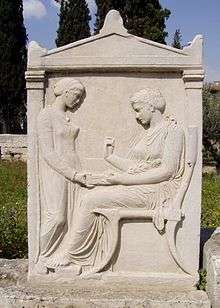
Some items entirely in metal, such as lampstands, braziers and stands for sacrifice, have survived, and some covered by the eruption of Mount Vesuvius have either been carbonized or left hollows in the volcanic rock that can be used as moulds for plaster of Paris, allowing a clear idea of their original form. The rich had tables and chairs supported by marble, and some of these have survived. Wicker was widely used for armchairs.
Greek furniture
Ancient Greek furniture was typically constructed out of wood, though it might also be made of stone or metal, such as bronze, iron, gold and silver. Little wood survives from ancient Greece, though varieties mentioned in texts concerning Greece and Rome include maple, oak, beech, yew, and willow.[1] Pieces were assembled using mortise-and-tenon joinery, held together with lashings, pegs, metal nails, and glue. Wood was shaped by carving, steam treatment, and the lathe, and furniture is known to have been decorated with ivory, tortoise shell, glass, gold or other precious materials.[2] Similarly, furniture could be veneered with expensive types of wood in order to make the object appear more costly,[3] though classical furniture was often pared down in comparison to objects attested in the East, or those from earlier periods in Greece.[4]
Extensive research was done on the forms of Greek furniture by Gisela Richter, who utilized a typological approach based primarily on illustrated examples depicted in Greek art, and it is from Richter’s account that the main types can be delineated.[5]
Greek seating
The modern word “throne” is derived from the ancient Greek thronos (Greek singular: θρόνος), which was a seat designated for deities or individuals of high status or honor.[6] The colossal chryselephantine statue of Zeus at Olympia, constructed by Phidias and lost in antiquity, featured the god Zeus seated on an elaborate throne, which was decorated with gold, precious stones, ebony and ivory, according to Pausanias.[7] Less extravagant though more influential in later periods is the klismos (Greek singular: κλισμός), an elegant Greek chair with a curved backrest and legs whose form was copied by the Romans and is now part of the vocabulary of furniture design. A fine example is shown on the grave stele of Hegeso, dating to the late fifth century BCE.[8] As with earlier furniture from the east, the klismos and thronos could be accompanied by footstools.[9] There are three types of footstools outlined by Richter – those with plain straight legs, those with curved legs, and those shaped like boxes that would have sat directly on the ground.[10]
The most common form of Greek seat was the backless stool, which must have been found in every Greek home. These were apparently known as diphroi (Greek singular: δίφρος), and were easily portable.[11] The Parthenon frieze displays numerous examples, upon which the gods are seated.[12] Several fragments of a stool were discovered in a fourth-century BCE. tomb in Thessaloniki, including two of the legs and four transverse stretchers. Once made of wood and covered in silver foil, all that remains of this piece are the parts made of precious metal.[13]
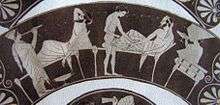
The folding stool, known as the diphros okladias (Greek singular: δίφρος ὀκλαδίας), was practical and portable. The Greek folding stool survives in numerous depictions, indicating its popularity in the Archaic and Classical periods; the type may have been derived from earlier Minoan and Mycenaean examples, which in turn were likely based on Egyptian models.[14] Greek folding stools might have plain straight legs or curved legs that typically ended in animal feet.[15]
Klinai
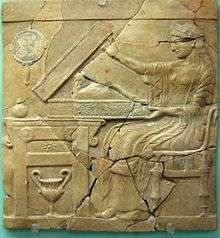
A couch or kline (Greek: κλίνη) was a form used in Greece as early as the late seventh century B.C.E.[16] The kline was rectangular and supported on four legs, two of which could be longer than the other, providing support for an armrest or headboard. Three types are distinguished by Richter – those with animal legs, those with “turned” legs, and those with “rectangular” legs, although this terminology is somewhat problematic.[17] The fabric would have been draped over the woven platform of the couch, and cushions would have been placed against the arm or headrest, making the Greek couch an item well suited for a symposium gathering. The foot of a bronze bed discovered in situ in the House of the Seals at Delos provides an indication of how the “turned” legs of a kline might have appeared.[18] Numerous images of klinai are displayed on vases, topped by layers of intricately woven fabrics and pillows. These furnishings would have been made of leather, wool, or linen, though silk could also have been used. Stuffing for pillows, cushions, and beds could have been made of wool, feathers, leaves, or hay.[19]
Greek tables
In general, Greek tables (Greek singular: τράπεζα, τρἰπους, τετράπους, φάτνη, ὲλεóς) were low and often appear in depictions alongside klinai and could perhaps fit underneath.[20] The most common type of Greek table had a rectangular top supported on three legs, though numerous configurations exist. Tables could have circular tops, and four legs or even one central leg instead of three. Tables in ancient Greece were used mostly for dining purposes – in depictions of banquets, it appears as though each participant would have utilized a single table, rather than a collective use of a larger piece. On such occasions, tables would have been moved according to one's needs.[21]
Tables also would have figured prominently in religious contexts, as indicated in vase paintings. One example by the Chicago Painter from The Art Institute of Chicago, dating to around 450 B.C.E., shows an image of three women performing a Dionysian ritual, in which a table functions as an appropriate place to rest a kantharos – a wine vessel associated with Dionysus.[22] Other images indicate that tables could range in style from the highly ornate to the relatively unadorned.
Roman furniture

To a large extent, the types and styles of ancient Roman furniture followed those of their Classical and Hellenistic Greek predecessors. Because of this it is difficult to differentiate Roman forms from earlier Hellenistic ones in many cases. Gisela Richter’s typological approach is useful in tracing developments of Greek furniture into Roman expressions.[23] Knowledge of Roman furniture is derived mainly from depictions in frescoes and representations in sculpture, along with actual pieces of furniture, fragments, and fittings, several of which were preserved by the eruption of Vesuvius in AD 79. The most well-known archaeological sites with preserved images and fragments from the eruption are Pompeii and Herculaneum in Italy. There are fine examples of reconstructed Roman furniture at the Metropolitan Museum of Art in New York City as well as the Capitoline Museum in Rome.
Chairs
The sella, or stool or chair, was the most common type of seating in the Roman period, probably because of its easy portability. In addition, the sella in its simplest form was inexpensive to make. Both slaves and emperors used it, although those of the poor were surely plain, while the wealthy had access to precious woods, ornamented with inlay, metal fittings, ivory, and silver and gold leaf. Bronze sellae from Herculaneum were square in form and had straight legs, decorative stretchers, and a dished seat.[24] The sella curulis, or folding stool, was an important indicator of power in the Roman period.[25] There were sellae resembling both stools and chairs that folded in a scissor fashion to facilitate transport.[26]
The Roman cathedra was a chair with a back, although there is disagreement as to the exact meaning of the Latin term. Richter defines the cathedra as a later version of the Greek klismos, which she says was never as popular as its Greek predecessor.[27] A. T. Croom, however, considers the cathedra to be a high-backed wickerwork chair that was typically associated with women. They have also been seen being used as early school teachers, pupils would sit around him in this chair while he taught. It showed who held the seat of power in the classroom.[28] As with Greek furniture, the names of various Roman types as found in texts cannot always be associated with known furniture forms with certainty.
The Latin solium is considered to be equivalent to the Greek term thronos and thus is often translated as “throne.”[29] These were like modern chairs, with backs and arm rests. Three types of solia based on Greek prototypes are distinguished by Richter: thrones with “turned” and “rectangular” legs and grandiose thrones with solid sides, of which several examples remain in stone.[30] In addition, a type with a high back and arms, resting upon a cylindrical or conical base, is said to derive from Etruscan prototypes.[31]
Couches
Few actual Roman couches survive, although sometimes the bronze fittings do, which help with the reconstruction of the original forms. While in wealthy households beds were used for sleeping in the bedrooms (lectus cubicularis), and couches for banqueting while reclining were used in the dining rooms (lectus tricliniaris), the less well off might use the same piece of furniture for both functions.[32] The two types might be used interchangeably even in richer households, and it is not always easy to differentiate between sleeping and dining furniture. The most common type of Roman bed took the form of a three-sided, open rectangular box, with the fourth (long) side of the bed open for access. While some beds were framed with boards, others had slanted structures at the ends, called fulcra, to better accommodate pillows. The fulcra of elaborate dining couches often had sumptuous decorative attachments featuring ivory, bronze, copper, gold or silver ornamentation.[33]
The bench, or subsellium, was an elongated stool for two or more users. Benches were considered to be “seats of the humble,” and were used in peasant houses, farms, and bathhouses. However, they were also found in lecture halls, in the vestibules of temples, and served as the seats of senators and judges. Roman benches, like their Greek precedents, were practical for the seating of large groups of people and were common in theaters, amphitheaters, odeons and auctions.[34] The scamnum, related to the subsellium but smaller, was used as both a bench and a footstool.[35]
Tables
Types of Roman tables include the abacus and the mensa, which are distinguished from one another in Latin texts. The term abacus might be used for utilitarian tables, such as those for making shoes or kneading dough, as well as high-status tables, such as sideboards for the display of silver.[36] A low, three-legged table, thought to represent the mensa delphica, was often depicted next to reclining banqueters in Roman paintings. This table has a round tabletop supported by three legs configured like those of a tripod.[37] Several wooden tables of this type were recovered from Herculaneum.
Remainings
The most important source for wooden furniture of the Roman period is the collection of carbonized furniture from Herculaneum. While the eruption of Vesuvius in 79 C.E. was tremendously destructive to the region, the hot liquid lava that engulfed the town of Herculaneum ultimately preserved the wooden furniture, shelves, doors, and shutters in carbonized form.[38] Their preservation, however, is imperiled, as some of the pieces remain in situ in their houses and shops, encased in unprotected glass or entirely open and accessible. Upon excavation, much of the furniture was conserved with paraffin wax mixed with carbon powder, which coats the wood and obscures important details such as decorations and joinery. It is now impossible to remove the wax coating without further damaging the furniture. Several wooden pieces were found with bone and metal fittings.[39]
Wooden shelving and racks are found in shops and kitchens in the Vesuvian sites, and one house has elaborate wooden room dividers.
 Greek bronze lampstand, 3rd century BC
Greek bronze lampstand, 3rd century BC- Marble table from Pompeii
- Bronze table from Pompeii
 Reconstructed living room
Reconstructed living room Table support from Roman Greece
Table support from Roman Greece.jpg) Bench from the women's baths at Herculaneum
Bench from the women's baths at Herculaneum- Racks for amphorae in a shop in Herculaneum
 House of the wooden partition (#8) in Herculaneum
House of the wooden partition (#8) in Herculaneum- Mosaic of Two women making a call on a witch, from Pompeii
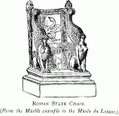 Roman throne with solid sides
Roman throne with solid sides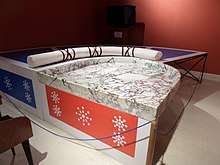 Diocletian's Mensa
Diocletian's Mensa
Notes
- G.M.A. Richter, The Furniture of the Greeks, Etruscans, and Romans (London: Phaidon, 1966), 122. First published in 1926 with an updated version in 1966.
- Richter, 125.
- Richter, 125-126.
- Stephanus T. A. M. Mols, Wooden Furniture in Herculaneum: Form, Technique and Function, in vol. 2 of Circumvesuviana (Amsterdam: Gieben, 1999), 10. These relatively simple varieties of furniture may be connected to ancient Greek sumptuary laws. The effects of these laws on craftsmen are discussed by Alison Burford in Craftsmen in Greek and Roman Society (Ithaca, NY: Cornell UP, 1972), 146.
- See section on “Greek Furniture” in Richter, 13-84, in which the author describes Greek furniture and its typology.
- Richter, 13.
- Richter, 14; NH 5.11.2ff.
- Linda Maria Gigante, “Funerary Art,” in The Oxford Encyclopedia of Ancient Greece and Rome, Vol. 1, ed. Michael Gagarin and Elaine Fantham (Oxford: Oxford University Press, 2010), 246.
- Richter, 49.
- Richter, 50-51.
- E. Guhl, and W. Koner, Everyday Life in Greek and Roman Times (New York: Crescent, 1989), 133.
- Elizabeth Simpson, “Furniture,” in The Oxford Encyclopedia of Ancient Greece and Rome, Vol. 1, ed. Michael Gagarin and Elaine Fantham (Oxford: Oxford University Press, 2010), 254.
- Dimitra Andrianou, The Furniture and Furnishings of Ancient Greek Houses and Tombs (New York: Cambridge University Press, 2009) 28-29, figure 6a.
- Ole Wanscher, Sella Curulis: The Folding Stool, an Ancient Symbol of Dignity (Copenhagen: Rosenkilde and Bagger, 1980), 83.
- Richter, 43.
- Simpson, 253.
- Richter, 54; Richter defines “turned” (as in lathe-turned) legs on page 19 as being tripartite, with a middle “lozenge-shaped” portion capped by conical, “flaring” pieces at either end. This terminology is problematic in that it implies woodworking techniques, while the “turned” leg could have been executed in other materials, such as stone, metal, or ivory. Richter defines “rectangular” legs on page 23 as those that are “straight” though these can be curved and footed and often decorated with palettes and volutes.
- Andrianou, 36.
- Richter, 117.
- Richter, 63.
- Richter, 66.
- Chicago Painter, stamnos, ca. 450 B.C.E. The Art Institute of Chicago, 1889.22.
- Richter, 97-116.
- Lucia Pirzio Biroli Stefanelli, Il bronzo dei romani: arredo e suppellettile (Rome: L’Erma" di Bretschneider, 1991), 140-142.
- Wanscher, 121.
- Roger B. Ulrich, Roman Woodworking (New Haven: Yale University Press, 2007), 221.
- Richter, 101; Ulrich, 215.
- A. T. Croom, Roman Furniture (Stroud, Gloucestershire, Great Britain: Tempus, 2007), 116.
- Richter, 98; Ulrich, 215-216.
- Richter, 98-101.
- Richter, 10. According to Ulrich, Pliny uses the Greek term cathedra instead of solium for wicker armchairs, 215-218. Croom, however, refers to this chair as cathedra on p. 116.
- Croom, 32.
- Ulrich, 232-233.
- Richter, 104; Croom, 110.
- Ulrich, 219.
- Ulrich, 223-224.
- Ulrich, 225.
- Mols, 1.
- Mols, 19.
References
| Wikimedia Commons has media related to Ancient furniture. |
- Andrianou, Dimitra. The Furniture and Furnishings of Ancient Greek Houses and Tombs. New York: Cambridge UP, 2009.
- Baker, Hollis S. Furniture in the Ancient World: Origins & Evolution, 3100-475 B.C. New York: Macmillan, 1966.
- Blakemore, Robbie G. History of Interior Design & Furniture: from Ancient Egypt to Nineteenth-century Europe. Hoboken, NJ: J. Wiley & Sons, 2006.
- Boger, Louise Ade. Furniture Past & Present: A Complete Illustrated Guide to Furniture Styles from Ancient to Modern. Garden City, NY: Doubleday, 1966.
- Burford, Alison. Craftsmen in Greek and Roman Society. Ithaca, NY: Cornell UP, 1972.
- Gigante, Linda Maria. “Funerary Art,” in The Oxford Encyclopedia of Ancient Greece and Rome. Vol. 1. Edited by Michael Gagarin and Elaine Fantham. Oxford: Oxford University Press, 2010.
- Guhl, E., and W. Koner. Everyday Life in Greek and Roman Times. New York: Crescent, 1989.
- Mols, Stephanus T.A.M. Wooden Furniture in Herculaneum: Form, Technique and Function. Vol. 2 of Circumvesuviana. Amsterdam: Gieben, 1999.
- Nevett, Lisa C. Domestic Space in Classical Antiquity. New York: Cambridge UP, 2010.
- Pollen, John Hungerford. Ancient and Modern Furniture and Woodwork. London: Pub. for the Committee of Council on Education, by Chapman and Hall, 1875. South Kensington Museum of Art Handbooks, No. 3.
- Richter, G.M.A. The Furniture of the Greeks, Etruscans, and Romans. London: Phaidon, 1966.
- Robsjohn-Gibbings, Terence Harold, and Carlton W. Pullin. Furniture of Classical Greece. New York: Knopf, 1963.
- Simpson, Elizabeth. “Furniture,” in The Oxford Encyclopedia of Ancient Greece and Rome. Vol. 1. Edited by Michael Gagarin and Elaine Fantham. Oxford: Oxford University Press, 2010.
- Wanscher, Ole. Sella Curulis: The Folding Stool, an Ancient Symbol of Dignity. Copenhagen: Rosenkilde and Bagger, 1980.
